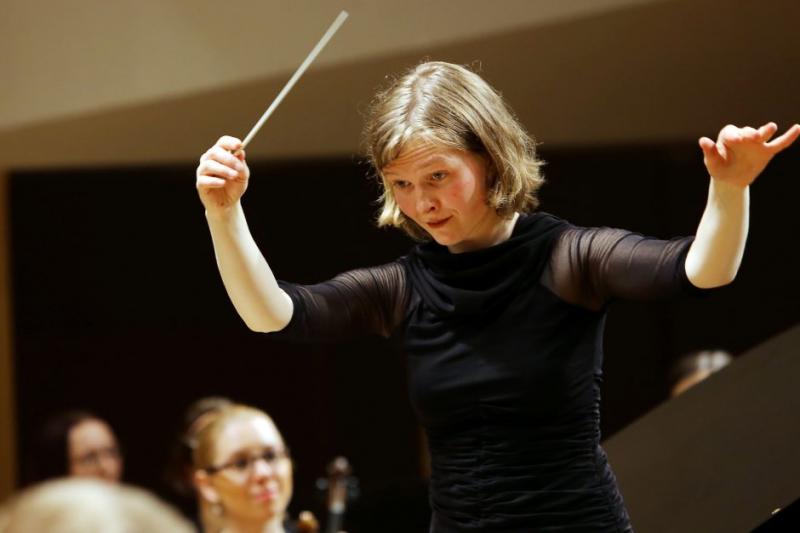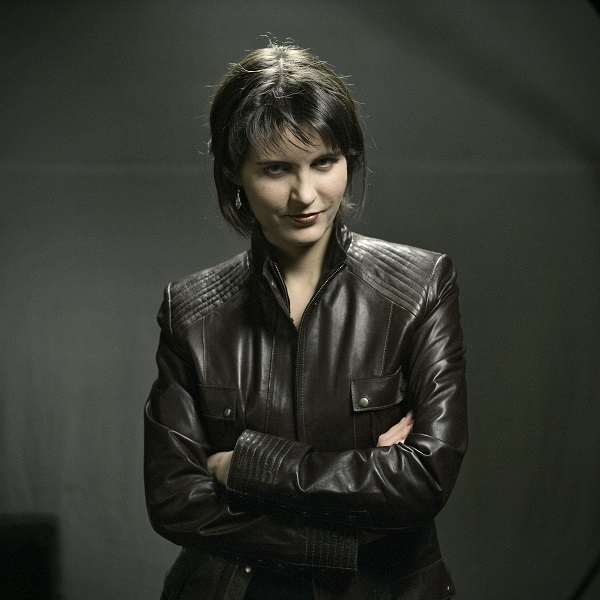CBSO, Gražinytė-Tyla, Symphony Hall Birmingham | reviews, news & interviews
CBSO, Gražinytė-Tyla, Symphony Hall Birmingham
CBSO, Gražinytė-Tyla, Symphony Hall Birmingham
Head and heart triumph together in Mahler, Haydn and a UK premiere

Is there anything on a concert programme more guaranteed to make the heart lift – or to prove that a conductor has their musical priorities straight – than a Haydn symphony? If you're tired of Haydn, you're tired of life: there’s no music more joyous, more inventive or more resistant to vanity. Mirga Gražinytė-Tyla chose his Symphony No 6 of 1761, called Le Matin for its opening sunrise and the freshness of its ideas, and it was a delight.
The six wind players stood up to play, and the CBSO strings were slimmed down a little, but not a lot. There was no serious attempt here to fake a period style; indeed, Gražinytė-Tyla seemed to be enjoying the forces at her disposal, revelling in her ability to unleash a big, full-bodied burst of string sound in a tutti, and encouraging her woodwinds and string principals to play out like soloists in a concerto grosso. Tempos were brisk but not frantic, and Haydn’s dynamic surprises and wonderfully varied colours – flute melodies, carolling horns, and the wood-smokey blend of cellos, basses and a warbling solo bassoon in the third movement’s central Trio section – made their mark with the lightest of touches. It was bright, it was playful, and above all it felt affectionate. Gražinytė-Tyla, having made her artistic choices, owned them with warmth and style: a point beautifully made. For every hundred conductors who can bring the house down with Mahler, only a handful can make Haydn sing like this.
She sees the whole symphony as a single cumulative sweep
Of course, Gražinytė-Tyla can do Mahler too. The second half of this concert comprised his First Symphony, though this won’t have been the only reason why Symphony Hall was packed (there weren’t even any empty seats in the choirstalls). This was Gražinytė-Tyla’s first concert as music director of the CBSO since her debut programme at this summer's BBC Proms; her first week-night programme in the orchestra’s main season, then, and Birmingham’s first taste of what – hopefully – will be business as usual for the next few years.
So if she planned it as a statement of artistic intent, it was an encouraging one, and not just because of the Haydn. Her predecessor Andris Nelsons often gave the impression that he was conducting contemporary music under duress. Gražinytė-Tyla, in contrast, opened with the UK premiere of Fires, a 10-minute squib (when did it become unacceptable to call an overture an overture?) by the Lithuanian composer Raminta Šerkšnyte (pictured below). A misterioso introduction erupts in thunderous, racing ostinati, while excited clarinet squawks and bluesy sighs from muted trombone hint at a slyly subversive creative personality that might well be worth investigating further. Gražinytė-Tyla charged it with a bristling, glinting energy, and the final punchline – a quote from Beethoven’s Fifth – drew laughter. As for the Mahler: if you thought there was nothing left for anyone to say about this most overplayed of warhorses, the huge scope and sheer control of Gražinytė-Tyla’s interpretation will have shaken up quite a few preconceptions. The first movement doesn’t have to resemble an introduction and sonata-allegro, of course, but I’ve never heard it played quite so persuasively as a single enormous prelude. Gražinytė-Tyla let the massive stillness of the opening bars overflow and seep into every part of the movement; only with the jubilant horn whoops at the climax of the recapitulation did all that pent-up longing finally run off the leash – ecstatically. And then onwards, sustaining that momentum: into an earthy scherzo that turned into a whirling, horn-driven vortex, and then that macabre fairy-tale funeral of a slow movement, with the opening bass solo played in a hushed unison by all eight CBSO basses.
As for the Mahler: if you thought there was nothing left for anyone to say about this most overplayed of warhorses, the huge scope and sheer control of Gražinytė-Tyla’s interpretation will have shaken up quite a few preconceptions. The first movement doesn’t have to resemble an introduction and sonata-allegro, of course, but I’ve never heard it played quite so persuasively as a single enormous prelude. Gražinytė-Tyla let the massive stillness of the opening bars overflow and seep into every part of the movement; only with the jubilant horn whoops at the climax of the recapitulation did all that pent-up longing finally run off the leash – ecstatically. And then onwards, sustaining that momentum: into an earthy scherzo that turned into a whirling, horn-driven vortex, and then that macabre fairy-tale funeral of a slow movement, with the opening bass solo played in a hushed unison by all eight CBSO basses.
In terms of Gražinytė-Tyla’s overall vision, that made perfect sense. It was clear by now that she sees the whole symphony as a single cumulative sweep. A sudden lurch to a solo instrument, at this point in the proceedings, would have undercut the depth of tone in which that vision was grounded. (It would be fascinating to hear her in Bruckner). Meanwhile the drama of her finale made good on everything that had been held back so far. Put like that, it sounds coolly logical; in fact, there’s an incredibly vivid and tactile quality to the sound Gražinytė-Tyla draws from her new orchestra. Pianissimo passages were taut and tremulous with contained rapture, and the strings surged over the peak of Mahler’s great central melody in an ardent, blazing swell of emotion. Mahler for the head or for the heart? Gražinytė-Tyla makes no distinction.
rating
Explore topics
Share this article
Add comment
The future of Arts Journalism
You can stop theartsdesk.com closing!
We urgently need financing to survive. Our fundraising drive has thus far raised £49,000 but we need to reach £100,000 or we will be forced to close. Please contribute here: https://gofund.me/c3f6033d
And if you can forward this information to anyone who might assist, we’d be grateful.

Subscribe to theartsdesk.com
Thank you for continuing to read our work on theartsdesk.com. For unlimited access to every article in its entirety, including our archive of more than 15,000 pieces, we're asking for £5 per month or £40 per year. We feel it's a very good deal, and hope you do too.
To take a subscription now simply click here.
And if you're looking for that extra gift for a friend or family member, why not treat them to a theartsdesk.com gift subscription?
more Classical music
 Bizet in 150th anniversary year: rich and rare French offerings from Palazzetto Bru Zane
Specialists in French romantic music unveil a treasure trove both live and on disc
Bizet in 150th anniversary year: rich and rare French offerings from Palazzetto Bru Zane
Specialists in French romantic music unveil a treasure trove both live and on disc
 Scottish Chamber Orchestra, Ibragimova, Queen’s Hall, Edinburgh review - rarities, novelties and drumrolls
A pity the SCO didn't pick a better showcase for a shining guest artist
Scottish Chamber Orchestra, Ibragimova, Queen’s Hall, Edinburgh review - rarities, novelties and drumrolls
A pity the SCO didn't pick a better showcase for a shining guest artist
 Kilsby, Parkes, Sinfonia of London, Wilson, Barbican review - string things zing and sing in expert hands
British masterpieces for strings plus other-worldly tenor and horn - and a muscular rarity
Kilsby, Parkes, Sinfonia of London, Wilson, Barbican review - string things zing and sing in expert hands
British masterpieces for strings plus other-worldly tenor and horn - and a muscular rarity
 From Historical to Hip-Hop, Classically Black Music Festival, Kings Place review - a cluster of impressive stars for the future
From quasi-Mozartian elegance to the gritty humour of a kitchen inspection
From Historical to Hip-Hop, Classically Black Music Festival, Kings Place review - a cluster of impressive stars for the future
From quasi-Mozartian elegance to the gritty humour of a kitchen inspection
 Shibe, LSO, Adès, Barbican review - gaudy and glorious new music alongside serene Sibelius
Adès’s passion makes persuasive case for the music he loves, both new and old
Shibe, LSO, Adès, Barbican review - gaudy and glorious new music alongside serene Sibelius
Adès’s passion makes persuasive case for the music he loves, both new and old
 Anja Mittermüller, Richard Fu, Wigmore Hall review - a glorious hall debut
The Austrian mezzo shines - at the age of 22
Anja Mittermüller, Richard Fu, Wigmore Hall review - a glorious hall debut
The Austrian mezzo shines - at the age of 22
 First Person: clarinettist Oliver Pashley on the new horizons of The Hermes Experiment's latest album
Compositions by members of this unusual quartet feature for the first time
First Person: clarinettist Oliver Pashley on the new horizons of The Hermes Experiment's latest album
Compositions by members of this unusual quartet feature for the first time
 Gesualdo Passione, Les Arts Florissants, Amala Dior Company, Barbican review - inspired collaboration excavates the music's humanity
At times it was like watching an anarchic religious procession
Gesualdo Passione, Les Arts Florissants, Amala Dior Company, Barbican review - inspired collaboration excavates the music's humanity
At times it was like watching an anarchic religious procession
 Classical CDs: Camels, concrete and cabaret
An influential American composer's 90th birthday box, plus British piano concertos and a father-and-son duo
Classical CDs: Camels, concrete and cabaret
An influential American composer's 90th birthday box, plus British piano concertos and a father-and-son duo
 Cockerham, Manchester Camerata, Sheen, Martin Harris Centre, Manchester review - re-enacting the dawn of modernism
Two UK premieres added to three miniatures from a seminal event of January 1914
Cockerham, Manchester Camerata, Sheen, Martin Harris Centre, Manchester review - re-enacting the dawn of modernism
Two UK premieres added to three miniatures from a seminal event of January 1914
 Kempf, Brno Philharmonic, Davies, Bridgewater Hall, Manchester review - European tradition meets American jazz
Bouncing Czechs enjoy their Gershwin and Brubeck alongside Janáček and Dvořák
Kempf, Brno Philharmonic, Davies, Bridgewater Hall, Manchester review - European tradition meets American jazz
Bouncing Czechs enjoy their Gershwin and Brubeck alongside Janáček and Dvořák
 Solomon, OAE, Butt, QEH review - daft Biblical whitewashing with great choruses
Even a top soprano and mezzo can’t make this Handel paean wholly convincing
Solomon, OAE, Butt, QEH review - daft Biblical whitewashing with great choruses
Even a top soprano and mezzo can’t make this Handel paean wholly convincing

Comments
I have attended CBSO concerts